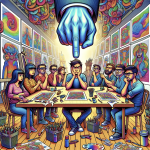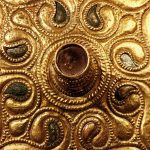

Imagine walking into a gallery, being captivated by a stunning piece of art, and realizing there’s no name attached to it. How does it make you feel? The absence of an artist’s name can evoke a sense of mystery and curiosity. In this article, we will explore the role and impact of anonymity in art, examining why some artists choose to remain nameless and how it affects their work and reception.
Historical Perspectives on Anonymity in Art
Anonymity in art is not a new concept. In ancient cultures such as Egypt, Greece, and Rome, many artworks were created by unknown artists. These works were often communal efforts or created by craftsmen whose names were not recorded. Thus, the focus was on the collective achievement rather than individual recognition.
During the medieval period in Europe, art was predominantly produced by guilds and workshops. Artists worked together on large-scale projects, often for religious or noble patrons. The emphasis was on the divine or the commissioner rather than the creator. As a result, many artworks from this period remain unsigned and unattributed.
However, the Renaissance marked a significant shift towards individual recognition in art. Artists like Leonardo da Vinci and Michelangelo became celebrated figures, and their names became synonymous with their works. This period saw the birth of the concept of the artist as a genius, where personal fame and artistic creation were closely linked.
Nevertheless, even during the Renaissance, there were still numerous anonymous works. Not all artists sought fame or recognition. Some preferred to remain in the shadows, allowing their work to speak for itself. This blend of anonymity and recognition highlights the complex nature of artistic identity.
Reasons for Anonymity in Art
Artists often choose anonymity for political and social reasons. Street art and graffiti, for example, frequently involve anonymous creators. These artists use their work to protest or challenge societal norms without revealing their identities. By remaining anonymous, they protect themselves from potential repercussions.
Additionally, philosophical and personal motivations play a role. Some artists believe that art should be appreciated independently of its creator. They argue that anonymity allows viewers to focus on the artwork itself rather than the personality behind it. This perspective emphasizes the art over the artist.
Furthermore, anonymity can also be a tool for artistic experimentation. By shedding their identities, artists can explore new styles and ideas without the constraints of their reputations. This freedom encourages innovation and creativity. Many artists have adopted pseudonyms or remained anonymous to challenge conventional norms and expectations.
Moreover, collective efforts further illustrate the appeal of anonymity. Groups like the Guerrilla Girls use anonymity to highlight gender and racial inequalities in the art world. Their collective identity underscores the idea that the message is more important than the messenger. This approach strengthens their impact and preserves their personal privacy.
The Impact of Anonymity on Art Reception
Anonymity significantly influences how viewers engage with art. Without a known creator, the interpretation of the artwork becomes more open-ended. Viewers are invited to project their own meanings and interpretations. This dynamic can make the viewing experience more personal and immersive.
An anonymous artist’s mystery can enhance the work’s psychological impact. People are naturally curious, and the absence of an artist’s identity can add a layer of intrigue. Consequently, this curiosity can lead to deeper engagement and contemplation. Anonymity can thus enrich the overall artistic experience.
Market dynamics are also affected by anonymity. Art valuation often hinges on the reputation of the artist. Anonymous works, lacking this context, can disrupt traditional valuation methods. However, in some cases, anonymity can create a unique allure that boosts an artwork’s value.
Comparing anonymous works to those by famous artists highlights these market effects. While the latter often fetch higher prices due to their creators’ fame, anonymous pieces can stand out for their mystery and uniqueness. This contrast reveals the complex interplay between identity, art, and market value. Anonymity challenges the conventional metrics of art appreciation and market dynamics.
Modern Anonymity: Case Studies
Banksy is a prime example of a modern anonymous artist. His street art, characterized by provocative and humorous themes, has garnered worldwide attention. Despite his anonymity, or perhaps because of it, Banksy’s work commands high prices and widespread acclaim. His identity remains a topic of speculation and fascination.
Another notable example is the contemporary collective The Yes Men. This group uses anonymity to execute elaborate pranks and social critiques. Their work highlights issues such as corporate greed and political corruption. By remaining anonymous, they protect themselves and emphasize their collective message.
Anonymity allows these artists to operate outside traditional art boundaries. Banksy and The Yes Men both challenge the status quo in unique ways. Their work often involves social and political commentary, amplified by their anonymity. This approach makes their messages more potent and impactful.
The societal implications of these practices are significant. Anonymous art can democratize artistic expression, making it more accessible and impactful. It can challenge power structures and provoke thought and discussion. In this way, modern anonymous artists continue a long tradition of using art as a tool for change.
Challenges and Criticisms
Anonymity in art raises questions about authorship and originality. Knowing the artist behind a work can provide context and enhance understanding. Some argue that anonymity diminishes the connection between the artist and the viewer. This perspective emphasizes the importance of the artist’s identity in interpreting art.
Critics also highlight issues of ownership and copyright. Anonymous works can complicate legal aspects of art ownership. This ambiguity can lead to disputes and challenges in attributing and protecting artistic creations. The lack of clear authorship can make it difficult to address these legal concerns.
Furthermore, forgery is another significant concern. Anonymous art is more susceptible to forgery and misattribution. Without a known creator, it is harder to verify the authenticity of a work. This challenge underscores the importance of provenance and documentation in the art world.
Additionally, ethical considerations also come into play. Anonymity can shield artists from accountability. This lack of accountability can lead to ethical dilemmas, particularly in politically or socially charged works. Balancing the benefits and drawbacks of anonymity requires careful consideration and responsible practice.
The Future of Anonymity in Art
The digital age offers new avenues for anonymous art. Online platforms and communities provide spaces for artists to share their work without revealing their identities. This digital anonymity can foster creativity and experimentation. However, it also presents challenges in terms of copyright and ownership.
Technology continues to reshape the landscape of anonymity in art. Digital tools allow for the creation and distribution of anonymous works on an unprecedented scale. This evolution opens up new possibilities for artistic expression. The future may see even more diverse and innovative forms of anonymous art.
Evolving attitudes towards anonymity will also shape its future. As society becomes more accustomed to digital and decentralized identities, perceptions of anonymity may change. This shift could lead to greater acceptance and appreciation of anonymous art. Understanding and embracing this trend will be crucial for the art world.
New forms of anonymous artistic expression are likely to emerge. Artists will continue to explore anonymity to push boundaries and challenge norms. This ongoing experimentation will keep the conversation about anonymity in art vibrant and dynamic. The question of anonymity will remain a vital and evolving topic in the art world.
Conclusion
Anonymity in art is a complex and multifaceted phenomenon. It offers artists freedom, protects their identities, and allows for innovative and provocative work. However, it also presents challenges related to authorship, ownership, and accountability. As we move forward, it’s essential to appreciate the art itself, beyond the identity of the artist, and to explore anonymous works with an open mind.
Exploring the world of anonymous art invites us to look deeper and think more critically. It challenges our perceptions and enriches our understanding of creativity. The question of anonymity in art is not just about the artist; it’s about how we engage with art and what it means to us. So next time you encounter an anonymous piece, let your curiosity lead the way.






